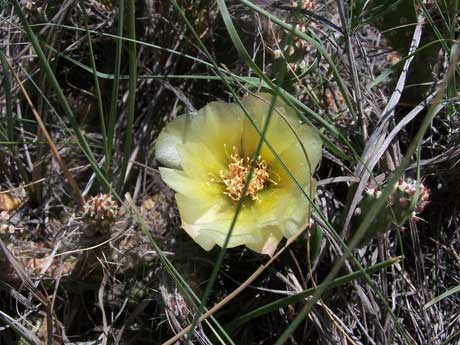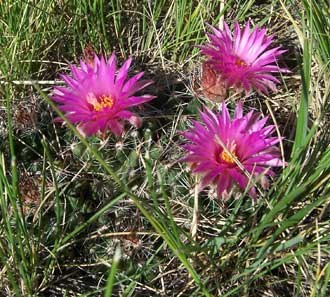
Cacti are not the first thing that springs to mind when thinking of a grassland, but Agate has three types. The average rainfall here is only 15 inches per year. We also have intense winds which increase evaporation and reduce available water. Cactus plants have special adaptations for dry climates, so they can survive this harsh environment better than other species Adapted to Deserts and Arid GrasslandsSucculent plants survive times of drought by storing water in their roots, stems or leaves. Cacti are stem succulents and they store the water in their pads (stem). They have a waxy coating to prevent loss of stored water. The unique thing about cacti is the presence of areoles, which produce spines and flowers. When a spine or branch from another plant gets broken off, it leaves behind damaged tissue that makes them more vulnerable to water loss. If a spine on a cactus is broken from the areoles, the plant is not damaged. Spines or Leaves? Why Not Both?The sharp spines are actually leaves that have adapted to break up wind and shade the pad, reducing evaporation. These spines also condense mists and dew at night, which then drip on the soil where they can be absorbed by roots. Cactus roots grow broad and shallow in order to quickly absorb rainwater when it comes, before drying out again later on during periods without precipitation. 
CAM Photosynthesis Saves WaterThe cactus lives in a harsh environment, so it uses Crassulacean acid metabolism (CAM) photosynthesis. Photosynthesis is the method by which plants collect carbon dioxide through holes in their leaves called "stomata" and convert it into sugar and oxygen with the use of sunlight. CAM is unique to succulent plants; during the day they open their stomata while retaining carbon dioxide and at night opening them only briefly when the air cools down. The sunlight is also absorbed through the stomata, even when they are closed. Colorful BloomsCacti at Agate bloom during the day in a variety of colors. The brittle cactus and prickly pears have beautiful yellow flowers that are hardy and last several days. |
Last updated: August 30, 2021
